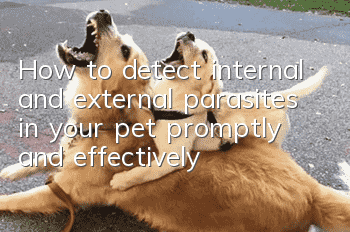How to detect internal and external parasites in your pet promptly and effectively?

Parasites have a certain incubation period. During the incubation period, cats and dogs usually do not have too obvious reactions, so it is very easy for parents to ignore them and miss the best treatment stage. Once the disease occurs, cats and dogs suffer, and owners feel distressed and worried. Here, the editor summarizes the early symptoms of common ectoparasites and internal parasites in cats and dogs. Owners of dogs and cats can detect parasites earlier by understanding them, avoid their pets suffering, and grow up healthily and happily. .
1. How to detect external parasites (fleas, lice, mites, ticks, etc.):
When cats and dogs are infected with ectoparasites in the early stages, they usually bite their tails, bodies, and scratch their ears more frequently than before; they are also easily irritable and will suddenly lie down and lick their bodies while sleeping or playing.
Initial inspection can reveal:
1) Check the ears and you will find brown dirt and smelly ears;
2) When you peel off the fur of a cat or dog, you will find flat, dark brown ant-sized objects on the skin, large soybean bugs that cling to the skin of the cat and dog, and white and slightly transparent particles.
2. How to detect internal parasites (roundworms, tapeworms, hookworms, heartworms, etc.):
When cats and dogs are infected with internal parasites in the early stages, they may appear to be thinner than usual, lack of energy, have loose stools, and be easily fatigued.
Initial inspection can reveal:
1) Cats and dogs excrete eggs and adult worms in their feces;
2) The feces has a rotten stench;
3) Loss of appetite;
4) Normal appetite but no weight gain or even weight loss;
5) There are white flat knobs around the anus of cats and dogs.
Notes for owners: Owners should pay more attention to the physical reactions of cats and dogs. Usually cats and dogs will show physical discomfort. Because the symptoms of parasite infection are not obvious in the early stage, it is easy for owners to ignore them. Once a dog is found to have the above symptoms, the owner should immediately check the cat or dog's body.
Diagnosis of internal parasites: Internal parasites are not easy to diagnose. Owners can go to a reliable pet hospital to conduct a laboratory test on their pet’s feces for diagnosis. Once confirmed, treat them in time. In addition, for internal parasites, it is best for owners to deworm them regularly.
Killing parasites in the cradle as early as possible can save the baby a lot of pain. For the sake of your dog, be more careful.
- Identifying colds in dogs
- How often do you need to deworm your dog in summer?
- The dog is jumping and barking excitedly? Teach you how to correct in 30 minutes
- How to improve dog food protection, dog food protection training methods!
- What's going on with golden retrievers having blood in their stools?
- Can puppies eat shrimp?
- When should puppies be dewormed externally?
- What should I do if my puppy eats desiccant?
- What is the reason why Alaskan dogs stagger when walking? A must-read for pet owners!
- What are the symptoms of anorexia in dogs?



